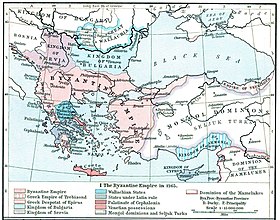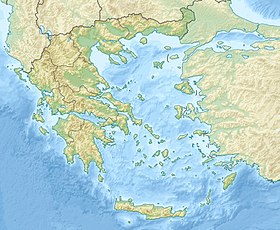Battle of Settepozzi
| Battle of Settepozzi | |||||||
|---|---|---|---|---|---|---|---|
| Part of the War of Saint Sabas | |||||||
 Map of the restored Byzantine Empire of Michael VIII Palaiologos and the surrounding states in 1265 | |||||||
| |||||||
| Belligerents | |||||||
| Republic of Venice |
Republic of Genoa Byzantine Empire | ||||||
| Commanders and leaders | |||||||
| Guiberto Dandolo |
Pietro Avvocato † Lanfranco Spinola 2 unnamed admirals | ||||||
| Strength | |||||||
| 32 galleys |
38 galleys 10 saette[a] (only 14 engaged) | ||||||
| Casualties and losses | |||||||
|
20 killed 400 wounded |
600 killed or wounded 400 captured 4 galleys captured | ||||||
Location within present-day Greece | |||||||
The Battle of Settepozzi was fought in the first half of 1263 off the Greek island of Settepozzi (the medieval Italian name for Spetses) between a Genoese–Byzantine fleet and a smaller Venetian fleet.
Genoa and the Byzantines had been allied against Venice since the Treaty of Nymphaeum in 1261, while Genoa, in particular, had been engaged in the War of Saint Sabas against Venice from 1256. In 1263, a Genoese fleet of 48 ships, which was sailing to the Byzantine stronghold of Monemvasia, encountered a Venetian fleet of 32 ships. The Genoese decided to attack, but only two of the four admirals of the Genoese fleet and 14 of its ships took part in the engagement, and were easily routed by the Venetians, who captured four vessels and inflicted considerable casualties.
The Venetian victory and the demonstration of Genoese reluctance to confront them in battle had considerable political repercussions, as the Byzantines began to distance themselves from their alliance with Genoa and restored their relations with Venice, concluding a five-year non-aggression pact in 1268. After Settepozzi, the Genoese avoided confrontation with the Venetian navy, instead focusing on commerce raiding. This did not prevent another, even more lopsided and complete defeat at the Battle of Trapani in 1266.
Background
When Michael VIII Palaiologos (r. 1259–1282) became ruler of the Byzantine Greek Empire of Nicaea, he set about realizing the Nicaean ambition to recover Constantinople, the former capital of the Byzantine Empire, which since the Fourth Crusade in 1204 had been the seat of the rival Latin Empire. By this time, the Latin Empire was a weak remnant of its former self, but was backed by the naval might of the Republic of Venice, which contributed to the failure of two large-scale Nicaean attempts to capture the city in 1235 and 1260.[1] The latter failure especially made the need to counter the Venetian fleet apparent to Palaiologos. Only one state possessed that capability: the Republic of Genoa.[2]
Venice's main commercial rival, Genoa had been embroiled since 1256 in the
In the event, Constantinople was recovered by the Nicaean general Alexios Strategopoulos barely a fortnight after the treaty was signed, without the need for Genoese naval assistance. Nevertheless, Michael VIII scrupulously observed the terms of the Treaty of Nymphaeum, as Genoese naval strength was still necessary to confront a potential Venetian counterstrike while a native Byzantine fleet was slowly being re-established.[5] With the Emperor's subsidies, the Genoese were able to increase their fleet strength considerably.[6] For a year after the recapture of Constantinople, both Venice and Genoa remained passive in the Aegean Sea: Venice hesitated to confront the numerically far superior fleet that Genoa had dispatched to the area, and awaited political developments in Italy, while Genoa suffered from internal turmoil with the overthrow of Boccanegra and the assumption of power by a collective leadership representing the noble houses of the city.[7]
In the summer of 1262, the Venetians ordered a 37-galley fleet under
Battle
Some time in early 1263, a Genoese fleet of 38 galleys and 10 saette,[a] crewed by some 6,000 men and commanded by four admirals, was sailing to the Byzantine fortress and naval base of Monemvasia in the south-eastern Morea.[13][14][15] At the island of Settepozzi (Spetses) it encountered a Venetian fleet of 32 galleys, under Guiberto Dandolo, sailing north to Negroponte.[14][15][16]
The details of the engagement are not very clear. According to the Genoese
According to the Annales Ianuenses, the hesitation of the Genoese fleet to engage may have been due to the fact that the Venetians claimed immunity as crusaders.
Questions of chronology and details
The 14th-century Venetian historian Andrea Dandolo placed the battle at the end of the tenth year of Doge Reniero Zeno's reign, i.e., either in late 1262 or January 1263, whereas the Annales Ianuenses simply record it under the year 1263. Modern historians generally place the battle in the spring of 1263:[23] the medievalist Georg Caro placed it in March at the latest,[24] whereas the naval historian Camillo Manfroni suggested May as the most likely time.[25] Geanakoplos, largely following Manfroni, placed the battle in the period May–July 1263.[16]
The Annales Ianuenses mention the battle directly after the sailing, on 28 May 1263, of a fleet of 25 galleys and six other ships to reinforce their fleet operating in the Aegean, under the admirals Pietrino Grimaldi and Pesceto Mallone, implying that they were involved in the battle.[10][26] However, the Byzantinist Albert Failler considers that this fleet probably sailed before news of Settepozzi had arrived in Genoa, and that it did not engage in any combat,[27] while the medievalist Michel Balard suggests that the fleet defeated at Settepozzi may have been sailing to Monemvasia to unite with the new fleet coming from Genoa.[28] While the fleet sailed for Monemvasia "on the emperor's orders" according to the Annales,[13] its direct connection with the Byzantine operations in the Morea, such as the arrival of Byzantine troops at Monemvasia mentioned in a letter of Pope Urban IV, is uncertain.[29]
In addition, the exact identity of the two admirals who were not engaged in battle is unknown. Canal reports that one of them was a Greek,[18] and the presence of Byzantine ships in the Genoese fleets is mentioned in the sources. However, the only Byzantine fleet commander attested by name during this time, Alexios Doukas Philanthropenos, was active in the Aegean islands, rather than along the coasts of the Greek mainland.[30]
Repercussions

Although most of the Genoese fleet survived the battle, and in its aftermath managed to capture four Venetian
Subsequently, the Genoese avoided direct confrontations with the Venetian battle fleet and engaged in
Apart from the loss in lives and ships, the long-term ramifications of the defeat at Settepozzi were political: Michael VIII began to reconsider the alliance with Genoa, which was very costly but had so far brought little in return.
Michael VIII signed a treaty with the Venetians on 18 June 1265, but it was not ratified by Doge Zeno. In the face of the threat from
Footnotes
References
- ^ Geanakoplos 1959, pp. 79–81.
- ^ Geanakoplos 1959, pp. 81–82.
- ^ Geanakoplos 1959, pp. 81–91.
- ^ Balard 1978, pp. 42–45.
- ^ Balard 1978, p. 46.
- ^ Balard 1978, pp. 46–47.
- ^ Geanakoplos 1959, pp. 147–150.
- ^ a b Geanakoplos 1959, p. 151.
- ^ Balard 1978, p. 47.
- ^ a b Imperiale di Sant'Angelo 1926, p. 49.
- ^ Geanakoplos 1959, pp. 157–159.
- ^ Dotson 2006, pp. 65–66.
- ^ a b c Imperiale di Sant'Angelo 1926, p. 51.
- ^ a b c d e f Lane 1973, p. 76.
- ^ a b c Wiel 1910, p. 168.
- ^ a b c d e Geanakoplos 1959, p. 153.
- ^ a b Wiel 1910, pp. 168–169.
- ^ a b Geanakoplos 1959, pp. 153–154 (note 70).
- ^ a b Wiel 1910, p. 169.
- ^ a b Dotson 2002, p. 122.
- ^ a b Imperiale di Sant'Angelo 1926, p. xlvii.
- ^ Geanakoplos 1959, p. 154.
- ^ Failler 1980, p. 102 (esp. note 52).
- ^ Caro 1895, p. 131.
- ^ Manfroni 1902, p. 9.
- ^ Balard 1978, p. 48.
- ^ Failler 1980, pp. 101–102.
- ^ Balard 1978, p. 48 (note 122).
- ^ Failler 1980, p. 102.
- ^ Failler 1980, pp. 101, 102.
- ^ Imperiale di Sant'Angelo 1926, p. 52.
- ^ Imperiale di Sant'Angelo 1926, pp. xlvii, 52–53.
- ^ Geanakoplos 1959, pp. 162–163.
- ^ Lane 1973, pp. 76, 77.
- ^ Dotson 1999, pp. 168–176.
- ^ Dotson 1999, pp. 176–179.
- ^ Lane 1973, p. 77.
- ^ Wiel 1910, p. 176.
- ^ Geanakoplos 1959, pp. 154, 161.
- ^ Geanakoplos 1959, pp. 161 (note 1), 163.
- ^ Geanakoplos 1959, pp. 161–164.
- ^ Geanakoplos 1959, pp. 168–171.
- ^ Setton 1976, p. 100.
- ^ Geanakoplos 1959, pp. 213–215.
Sources
- Balard, Michel (1978). La Romanie génoise (XIIe – Début du XVe siècle) [Genoese Romania (12th – early 15th century)] (in French). Vol. 1. Rome: École Française de Rome. OCLC 300152785.
- Caro, Georg (1895). Genua und die Mächte am Mittelmeer 1257–1311. Ein Beitrag zur Geschichte des XIII. Jahrhunderts. Erster Band [Genoa and the Powers of the Mediterranean 1257–1311. Contribution to the History of the 13th Century. First Volume.] (in German). Halle a. S.: Max Niemeyer. OCLC 457285419.
- Dotson, John E. (1999). "Fleet Operations in the First Genoese–Venetian War, 1264–1266". Viator. Medieval and Renaissance Studies. 30: 165–180. ISSN 0083-5897.
- Dotson, John E. (2002). "Venice, Genoa and Control of the Seas in the Thirteenth and Fourteenth Centuries". In Hattenforf, John B.; Unger, Richard W. (eds.). War at Sea in the Middle Ages and the Renaissance. Woodbridge, Suffolk: Boydell & Brewer. pp. 119–136. ISBN 0-85115-903-6.
- Dotson, John E. (2006). "Ship Types and Fleet Composition at Genoa and Venice in the Early Thirteenth Century". In Pryor, John (ed.). Logistics of Warfare in the Age of the Crusades: Proceedings of a Workshop Held at the Centre for Medieval Studies, University of Sydney, 30 September to 4 October 2002. Aldershot: Ashgate Publishing, Ltd. pp. 63–76. ISBN 978-0-7546-5197-0.
- Failler, Albert (1980). "Chronologie et composition dans l'Histoire de Georges Pachymère" [Chronology and composition in the History of George Pachymeres]. Revue des études byzantines (in French). 38: 5–103. .
- OCLC 1011763434.
- Imperiale di Sant'Angelo, Cesare, ed. (1926). Annali Genovesi di Caffaro e de'suoi continuatori, dal MCCLI al MCCLXXIX [Genoese Annals of Caffaro and of his continuators, from 1251 to 1279]. Fonti per la Storia d'Italia (in Italian and Latin). Rome: Instituto Storico Italiano. OCLC 257849033.
- ISBN 0-8018-1445-6.
- Manfroni, Camillo (1902). Storia della marina italiana, dal Trattato di Ninfeo alla caduta di Constantinopoli (1261–1453) [History of the Italian navy, from the Treaty of Nymphaeum to the Fall of Constantinople (1261–1453)] (in Italian). Livorno: R. Accademia navale. OCLC 265927738.
- ISBN 0-87169-114-0.
- Wiel, Alethea (1910). The Navy of Venice. New York: E. P. Dutton and Company. OCLC 4198755.

